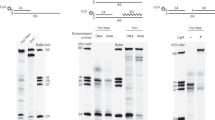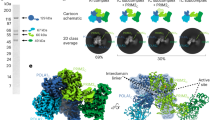Abstract
Genomic DNA is replicated by two DNA polymerase molecules, one of which works in close association with the helicase to copy the leading-strand template in a continuous manner while the second copies the already unwound lagging-strand template in a discontinuous manner through the synthesis of Okazaki fragments1,2. Considering that the lagging-strand polymerase has to recycle after the completion of every Okazaki fragment through the slow steps of primer synthesis and hand-off to the polymerase3,4,5, it is not understood how the two strands are synthesized with the same net rate6,7,8,9. Here we show, using the T7 replication proteins10,11, that RNA primers are made ‘on the fly’ during ongoing DNA synthesis and that the leading-strand T7 replisome does not pause during primer synthesis, contrary to previous reports12,13. Instead, the leading-strand polymerase remains limited by the speed of the helicase14; it therefore synthesizes DNA more slowly than the lagging-strand polymerase. We show that the primase–helicase T7 gp4 maintains contact with the priming sequence during ongoing DNA synthesis; the nascent lagging-strand template therefore organizes into a priming loop that keeps the primer in physical proximity to the replication complex. Our findings provide three synergistic mechanisms of coordination: first, primers are made concomitantly with DNA synthesis; second, the priming loop ensures efficient primer use and hand-off to the polymerase; and third, the lagging-strand polymerase copies DNA faster, which allows it to keep up with leading-strand DNA synthesis overall.
This is a preview of subscription content, access via your institution
Access options
Subscribe to this journal
Receive 51 print issues and online access
$199.00 per year
only $3.90 per issue
Buy this article
- Purchase on Springer Link
- Instant access to full article PDF
Prices may be subject to local taxes which are calculated during checkout




Similar content being viewed by others
References
Benkovic, S. J., Valentine, A. M. & Salinas, F. Replisome-mediated DNA replication. Annu. Rev. Biochem. 70, 181–208 (2001)
O’Donnell, M. Replisome architecture and dynamics in Escherichia coli . J. Biol. Chem. 281, 10653–10656 (2006)
Stukenberg, P. T., Turner, J. & O’Donnell, M. An explanation for lagging strand replication: polymerase hopping among DNA sliding clamps. Cell 78, 877–887 (1994)
Frick, D. N. & Richardson, C. C. DNA primases. Annu. Rev. Biochem. 70, 39–80 (2001)
Patel, S. S., Hingorani, M. M. & Ng, W. M. The K318A mutant of bacteriophage T7 DNA primase–helicase protein is deficient in helicase but not primase activity and inhibits primase–helicase protein wild-type activities by heterooligomer formation. Biochemistry 33, 7857–7868 (1994)
Alberts, B. M. et al. Studies on DNA replication in the bacteriophage T4 in vitro system. Cold Spring Harb. Symp. Quant. Biol. 47, 655–668 (1983)
Wu, C. A., Zechner, E. L. & Marians, K. J. Coordinated leading- and lagging-strand synthesis at the Escherichia coli DNA replication fork. I. Multiple effectors act to modulate Okazaki fragment size. J. Biol. Chem. 267, 4030–4044 (1992)
Lee, J., Chastain, P. D., Kusakabe, T., Griffith, J. D. & Richardson, C. C. Coordinated leading and lagging strand DNA synthesis on a minicircular template. Mol. Cell 1, 1001–1010 (1998)
Salinas, F. & Benkovic, S. J. Characterization of bacteriophage T4-coordinated leading- and lagging-strand synthesis on a minicircle substrate. Proc. Natl Acad. Sci. USA 97, 7196–7201 (2000)
Donmez, I. & Patel, S. S. Mechanisms of a ring shaped helicase. Nucleic Acids Res. 34, 4216–4224 (2006)
Hamdan, S. M. & Richardson, C. C. Motors, switches, and contacts in the replisome. Annu. Rev. Biochem. 78, 205–243 (2009)
Lee, J. B. et al. DNA primase acts as a molecular brake in DNA replication. Nature 439, 621–624 (2006)
Hamdan, S. M., Loparo, J. J., Takahashi, M., Richardson, C. C. & van Oijen, A. M. Dynamics of DNA replication loops reveal temporal control of lagging-strand synthesis. Nature 457, 336–339 (2009)
Stano, N. M. et al. DNA synthesis provides the driving force to accelerate DNA unwinding by a helicase. Nature 435, 370–373 (2005)
Donmez, I. & Patel, S. S. Coupling of DNA unwinding to nucleotide hydrolysis in a ring-shaped helicase. EMBO J. 27, 1718–1726 (2008)
Jeong, Y. J., Levin, M. K. & Patel, S. S. The DNA-unwinding mechanism of the ring helicase of bacteriophage T7. Proc. Natl Acad. Sci. USA 101, 7264–7269 (2004)
Ha, T. et al. Initiation and re-initiation of DNA unwinding by the Escherichia coli Rep helicase. Nature 419, 638–641 (2002)
Yang, J., Trakselis, M. A., Roccasecca, R. M. & Benkovic, S. J. The application of a minicircle substrate in the study of the coordinated T4 DNA replication. J. Biol. Chem. 278, 49828–49838 (2003)
Yao, N. Y., Georgescu, R. E., Finkelstein, J. & O’Donnell, M. E. Single-molecule analysis reveals that the lagging strand increases replisome processivity but slows replication fork progression. Proc. Natl Acad. Sci. USA 106, 13236–13241 (2009)
Corn, J. E., Pelton, J. G. & Berger, J. M. Identification of a DNA primase template tracking site redefines the geometry of primer synthesis. Nature Struct. Mol. Biol. 15, 163–169 (2008)
Myong, S. et al. Cytosolic viral sensor RIG-I is a 5′-triphosphate-dependent translocase on double-stranded RNA. Science 323, 1070–1074 (2009)
Sanborn, M. E., Connolly, B. K., Gurunathan, K. & Levitus, M. Fluorescence properties and photophysics of the sulfoindocyanine Cy3 linked covalently to DNA. J. Phys. Chem. B 111, 11064–11074 (2007)
Liu, S., Abbondanzieri, E. A., Rausch, J. W., Le Grice, S. F. & Zhuang, X. Slide into action: dynamic shuttling of HIV reverse transcriptase on nucleic acid substrates. Science 322, 1092–1097 (2008)
Selick, H. E. et al. in DNA Replication and Recombination (eds McMacken, R. & Kelly, T. J.) 183–214 (Alan R. Liss Inc., 1987)
Hamdan, S. M. et al. A unique loop in T7 DNA polymerase mediates the binding of helicase-primase, DNA binding protein, and processivity factor. Proc. Natl Acad. Sci. USA 102, 5096–5101 (2005)
McInerney, P., Johnson, A., Katz, F. & O’Donnell, M. Characterization of a triple DNA polymerase replisome. Mol. Cell 27, 527–538 (2007)
Yang, J., Nelson, S. W. & Benkovic, S. J. The control mechanism for lagging strand polymerase recycling during bacteriophage T4 DNA replication. Mol. Cell 21, 153–164 (2006)
Patel, S. S., Rosenberg, A. H., Studier, F. W. & Johnson, K. A. Large scale purification and biochemical characterization of T7 primase/helicase proteins. Evidence for homodimer and heterodimer formation. J. Biol. Chem. 267, 15013–15021 (1992)
Patel, S. S., Wong, I. & Johnson, K. A. Pre-steady-state kinetic analysis of processive DNA replication including complete characterization of an exonuclease-deficient mutant. Biochemistry 30, 511–525 (1991)
Ha, T. Single-molecule fluorescence resonance energy transfer. Methods 25, 78–86 (2001)
Rasnik, I., McKinney, S. A. & Ha, T. Nonblinking and long-lasting single-molecule fluorescence imaging. Nature Methods 3, 891–893 (2006)
Acknowledgements
We thank C. M. Drain for a critical reading of the paper, K. Picha and S. Patel for preparation of the minicircle DNA, and S. Arslan and K. S. Lee for help with single-molecule FRET data analysis. This work was supported by NIH grants GM55310 (S.S.P.) and GM065367 (T.H.) and NSF grants 0822613 and 0646550 (T.H.). T.H. is an investigator with the Howard Hughes Medical Institute.
Author Contributions M.P. purified T7 gp5 and T7 gp4, and constructed DNA substrates for the priming-loop studies, and obtained and analysed all the ensemble DNA synthesis and primer synthesis experiments. S.S. developed robust single-molecule assays for observing DNA unwinding and priming-loop formation, and obtained and analysed all single-molecule data. I.D. and G.P. performed the ensemble unwinding experiments. M.P., S.S., S.S.P. and T.H. designed the experiments, analysed the data and wrote the manuscript.
Author information
Authors and Affiliations
Corresponding authors
Supplementary information
Supplementary Information
This file contains Supplementary Methods, Supplementary Tables 1-3, Supplementary Figures 1-13 with Legends and Supplementary References. (PDF 2040 kb)
Rights and permissions
About this article
Cite this article
Pandey, M., Syed, S., Donmez, I. et al. Coordinating DNA replication by means of priming loop and differential synthesis rate . Nature 462, 940–943 (2009). https://doi.org/10.1038/nature08611
Received:
Accepted:
Published:
Issue Date:
DOI: https://doi.org/10.1038/nature08611
This article is cited by
-
Helicase promotes replication re-initiation from an RNA transcript
Nature Communications (2018)
-
New insights in pre-replication complex formation with single-molecule visualization
Science Bulletin (2015)
-
Studying genomic processes at the single-molecule level: introducing the tools and applications
Nature Reviews Genetics (2013)
-
Bacterial replication, transcription and translation: mechanistic insights from single-molecule biochemical studies
Nature Reviews Microbiology (2013)
-
E. coliDNA replication in the absence of free β clamps
The EMBO Journal (2011)
Comments
By submitting a comment you agree to abide by our Terms and Community Guidelines. If you find something abusive or that does not comply with our terms or guidelines please flag it as inappropriate.



